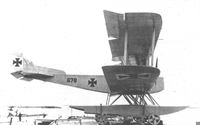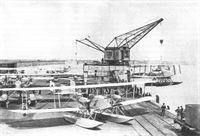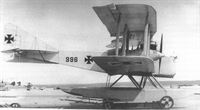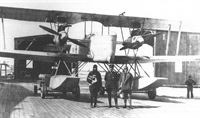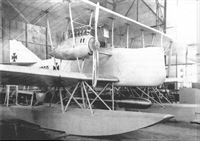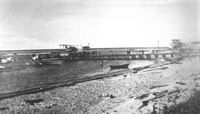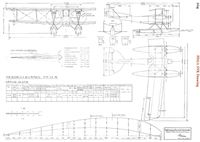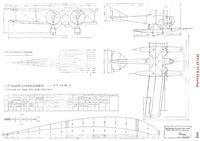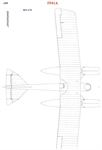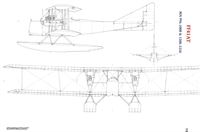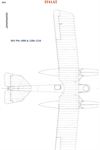
Описание
Страна: Германия
Год: 1916
Варианты
- Friedrichshafen - FF35 - 1915 - Германия
- Friedrichshafen - FF41 - 1916 - Германия
- Friedrichshafen - FF53 - 1917 - Германия
- O.Thetford, P.Gray German Aircraft of the First World War (Putnam)
- J.Herris Friedrichshafen Aircraft of WWI (A Centennial Perspective on Great War Airplanes 21)
- M.Schmeelke "Torpedo Los!" (Aeronaut)
- Журнал Flight
-
M.Schmeelke - "Torpedo Los!" /Aeronaut/
FF41AT MN 1000; on 21 August 1917 this aircraft, commanded by Ltn.z.S. Wolfram Eisenlohr, bombed and sank the Russian destroyer Stroini.
-
J.Herris - Friedrichshafen Aircraft of WWI /Centennial Perspective/ (21)
FF41AT MN 1000; on 21 August 1917 this aircraft, commanded by Ltn.z.S. Wolfram Eisenlohr, bombed and sank the Russian destroyer Stroini.
-
J.Herris - Friedrichshafen Aircraft of WWI /Centennial Perspective/ (21)
FF41AT in postwar Estonian service. Serialed '55'; its original Marine Number is not known.
-
J.Herris - Friedrichshafen Aircraft of WWI /Centennial Perspective/ (21)
The FF41 AT prototype torpedo bomber on its beaching dolly outside the assembly hall. The FF41 AT had a central fin and three rudders; the production FF41 AT had a simplified tail with a single large fin and rudder.
-
J.Herris - Friedrichshafen Aircraft of WWI /Centennial Perspective/ (21)
The sole FF41A prototype torpedo bomber on its beaching dolly outside the assembly hall. The FF41A had a central fin and three rudders; the production FF41AT had a simplified tail with a single fin and rudder.
-
M.Dusing - German Aviation Industry in WWI. Volume 2 /Centennial Perspective/ (85)
Fdh FF41A (1916). The FF41 was the counterpart to the FF40. Due to the positive experience with the FF38 (Fdh G.II), two Benz Bz.III engines were used. In contrast to the FF41 AT (#996-1000,1208-1210), the FF.41 A (#678) had slightly shorter but wider floats.
-
J.Herris - Friedrichshafen Aircraft of WWI /Centennial Perspective/ (21)
The sole FF41A prototype torpedo bomber on its beaching dolly. The Marine Number was applied in small digits on the nose below the window and the national insignia has been applied to the rudders.
-
J.Herris - Friedrichshafen Aircraft of WWI /Centennial Perspective/ (21)
The FF41A Marine Number 678 is in the foreground. At right Brandenburg GW Marine Number 701 is being hoisted into the water carrying a torpedo; another torpedo-carrying GW awaits its turn behind Marine Number 678. Despite being a single prototype, #678 was assigned to Zeebrugge where it was assembled and test flown. Performance was judged to be poor and, as far as is known, no operational missions were flown.
Другие самолёты на фотографии: Hansa-Brandenburg GW / GDW - Германия - 1916
-
M.Schmeelke - "Torpedo Los!" /Aeronaut/
Friedrichshafen FF 41A, serial 679, the first of three of these three-seat torpedo bombers to be built for the navy in late 1916-early 1917. Seen here at Zeebrugge on the Belgian coast, the FF 41A used two 150hp Benz Bz IIIs, giving it a top speed of 77.7mph, with a range of 357 miles. The Pintsch torpedo aiming device is attached to the nose. There is no torpedo attached. The FF41 AT turned out to be unsuitable for use as torpedo aircraft.
-
M.Schmeelke - "Torpedo Los!" /Aeronaut/
FF41A Marine Number 678 torpedo bomber with torpedo under test before markings were applied of the engine nacelles were fitted.
-
J.Herris - Friedrichshafen Aircraft of WWI /Centennial Perspective/ (21)
FF41A Marine Number 678 torpedo bomber with torpedo under test before the engine nacelles were fitted.
The type was modestly successful in combat due to its limited ability to carry its torpedo; most of its operations were dropping bombs. -
M.Schmeelke - "Torpedo Los!" /Aeronaut/
FF41A Marine Number 678 torpedo bomber with torpedo under test before the engine nacelles were fitted.
-
J.Herris - Friedrichshafen Aircraft of WWI /Centennial Perspective/ (21)
FF41A Marine Number 678 torpedo bomber in the assembly building before the engine nacelles were fitted.
-
J.Herris - Friedrichshafen Aircraft of WWI /Centennial Perspective/ (21)
The tail of this aircraft is not clearly visible in the photo, but it appears to be the FF41A prototype torpedo bomber afloat outside the assembly hall before its Marine Number and national insignia were applied and engine cowlings were fitted.
-
M.Schmeelke - "Torpedo Los!" /Aeronaut/
The FF41A prototype torpedo bomber afloat outside the assembly hall before its Marine Number and national insignia were applied and engine cowlings were fitted.
-
M.Schmeelke - "Torpedo Los!" /Aeronaut/
The sole FF41A prototype torpedo bomber afloat outside the assembly hall before its Marine Number and national insignia were applied and engine cowlings were fitted. The multiple rudders are visible.
-
M.Schmeelke - "Torpedo Los!" /Aeronaut/
The sole FF41A prototype torpedo bomber afloat outside the assembly hall before its Marine Number and national insignia were applied and engine cowlings were fitted. The multiple rudders are visible.
-
Журнал - Flight за 1919 г.
F.F. 41A
-
J.Herris - Friedrichshafen Aircraft of WWI /Centennial Perspective/ (21)
This aircraft is neither FF41A Marine Number 678 nor a later FF41AT; instead, it may be an intermediate design. Might this be Marine Number 735, the Friedrichshafen torpedo bomber that was cancelled?
-
M.Schmeelke - "Torpedo Los!" /Aeronaut/
FF41 AT torpedo bomber being inspected by dignitaries.
-
M.Schmeelke - "Torpedo Los!" /Aeronaut/
FF41 AT (with a mine tank) flew at the Angernsee Seaplane Station in Courland in October 1917.
-
J.Herris - Friedrichshafen Aircraft of WWI /Centennial Perspective/ (21)
Marine Number 996, the first FF41AT torpedo bomber built, on its beaching dolly.
-
O.Thetford, P.Gray - German Aircraft of the First World War /Putnam/
Friedrichshafen FF 41 (single tail)
-
J.Herris - Friedrichshafen Aircraft of WWI /Centennial Perspective/ (21)
Marine Number 996, the first FF41AT torpedo bomber built, on its beaching dolly.
-
M.Schmeelke - "Torpedo Los!" /Aeronaut/
Marine Number 997, the second FF41AT torpedo bomber built, is being eased into the water. The wheeled chassis under the floats being restrained through ropes by the handling crew. When in deep enough water the buoyancy of the floats lifted the aircraft from the wheeled chassis, which was then retrieved and usually stowed on the slipway for a reverse operation when the seaplane returned. The production FF41AT aircraft were flown extensively on operations in the Baltic, but these missions were primarily mine laying, conventional bombing, and maritime reconnaissance, not torpedo bombing.
-
J.Herris - Friedrichshafen Aircraft of WWI /Centennial Perspective/ (21)
Marine Number 998, the third FF41AT torpedo bomber built, with spherical bombs mounted underneath in the location also used for a torpedo.The aircraft commander's machine gun is protected by a canvas cover.
-
J.Herris - Friedrichshafen Aircraft of WWI /Centennial Perspective/ (21)
Marine Number 999, the fourth FF41AT torpedo bomber built. The radiators are mounted above the engines, which are enclosed in streamlined nacelles.
-
M.Schmeelke - "Torpedo Los!" /Aeronaut/
Marine Number 999, the fourth FF41 AT torpedo bomber built. (The Peter M. Bowers Collection/The Museum of Flight)
-
J.Herris - Friedrichshafen Aircraft of WWI /Centennial Perspective/ (21)
The Friedrichshafen FF41a, one of the early torpedo bomber designs, was powered by a pair of 150 hp Benz Bz.III engines. This was barely enough power to take off carrying a torpedo until ideal water conditions. FF41a Marine #1000 sunk a Russian destroyer by bombing in the Gulf of Riga.
-
M.Schmeelke - "Torpedo Los!" /Aeronaut/
Marine Number 1000, the fifth FF41AT torpedo bomber built and the last aircraft of the first production batch, being loaded with a torpedo.
-
M.Schmeelke - "Torpedo Los!" /Aeronaut/
Marine Number 1000, the fifth FF41AT torpedo bomber built and the last aircraft of the first production batch.
-
M.Schmeelke - "Torpedo Los!" /Aeronaut/
Marine Number 1000, the fifth FF41AT torpedo bomber built and the last aircraft of the first production batch photographed at Windau.
-
J.Herris - Friedrichshafen Aircraft of WWI /Centennial Perspective/ (21)
Lineup of FF41AT torpedo bombers at Windau; from left, Marine Numbers 1208, 996, and 1000.
-
J.Herris - Friedrichshafen Aircraft of WWI /Centennial Perspective/ (21)
Launching FF41AT torpedo bombers at Windau; from left, Marine Numbers 996 and 1000.
-
M.Schmeelke - "Torpedo Los!" /Aeronaut/
Seaplanes in Windau. (KMF)
-
M.Schmeelke - "Torpedo Los!" /Aeronaut/
Torpedo aircraft and other floatplanes at Windau. (KMF)
-
M.Schmeelke - "Torpedo Los!" /Aeronaut/
A Friedrichshafen FF41 AT at Angernsee with supporting personnel.
-
M.Schmeelke - "Torpedo Los!" /Aeronaut/
Group photo with an FF41 AT in Windau, 1917.
-
M.Schmeelke - "Torpedo Los!" /Aeronaut/
FF41 AT torpedo bomber in Estonian service postwar. This aircraft carries number "55" on the fuselage side and an interesting personal marking on the nose. (Courtesy F. Gerdessen)
-
M.Schmeelke - "Torpedo Los!" /Aeronaut/
A FF41 AT torpedo bomber in Estonian service postwar. This aircraft carries number "55" on the fuselage side and an interesting personal marking on the nose. (Courtesy F. Gerdessen)
-
J.Herris - Friedrichshafen Aircraft of WWI /Centennial Perspective/ (21)
FF41A SVK Drawing
-
J.Herris - Friedrichshafen Aircraft of WWI /Centennial Perspective/ (21)
FF41AT SVK Drawing
-
J.Herris - Friedrichshafen Aircraft of WWI /Centennial Perspective/ (21)
FF41AT MN 996-1000 & 1208-1210
-
J.Herris - Friedrichshafen Aircraft of WWI /Centennial Perspective/ (21)
FF41AT MN 996-1000 & 1208-1210
-
J.Herris - Friedrichshafen Aircraft of WWI /Centennial Perspective/ (21)
FF41AT MN 996-1000 & 1208-1210
O.Thetford, P.Gray German Aircraft of the First World War (Putnam)
Friedrichshafen FF 41 (compound tail)
Nine examples of FF 41 were built; in both single and compound tail versions, and supplied from February 1916 onwards. Intended for torpedo-carrying duties; a crew of three was carried. The twin 150 h.p. Benz Bz III engines were encased in neat metal housings and drove tractor airscrews. Span, 21.96 m. (72 ft. 0 3/4 in.). Length, 13.27 m. (43 ft. 6 1/2 in.). Height, 4.7 m. (15 ft. 5 1/8 in.). Area, 112.5 sq.m. (1,215 sq.ft.). Weights: Empty, 2,300 kg. (5,060 lb.). Loaded, 3,670 kg. (8,074 lb.). Speed, 125 km.hr. (78.125 m.p.h.). Range, 575 km. (360 miles). Armament, torpedo and manually operated machine-gun in front cockpit.
Описание:





